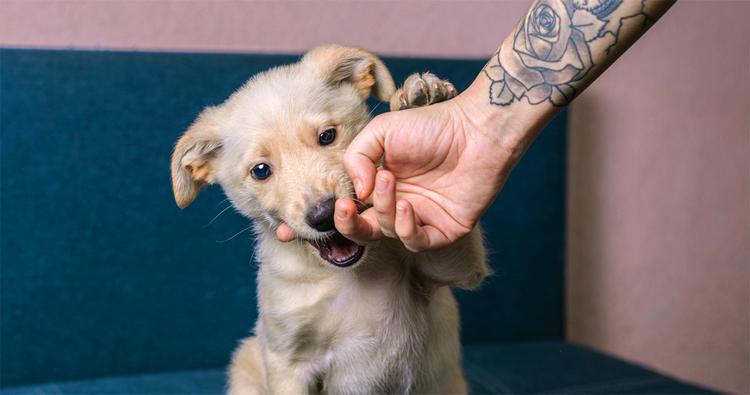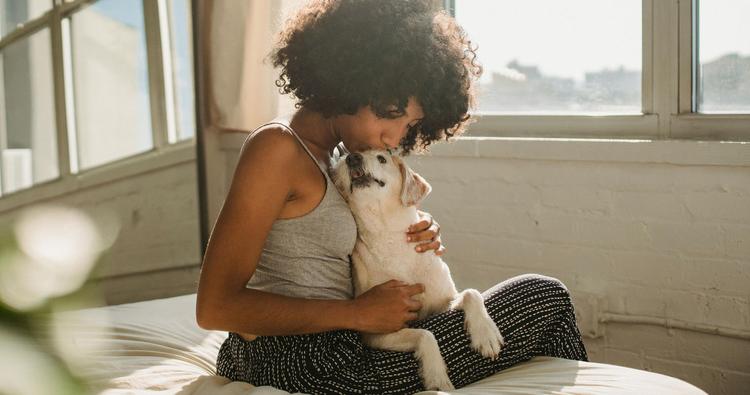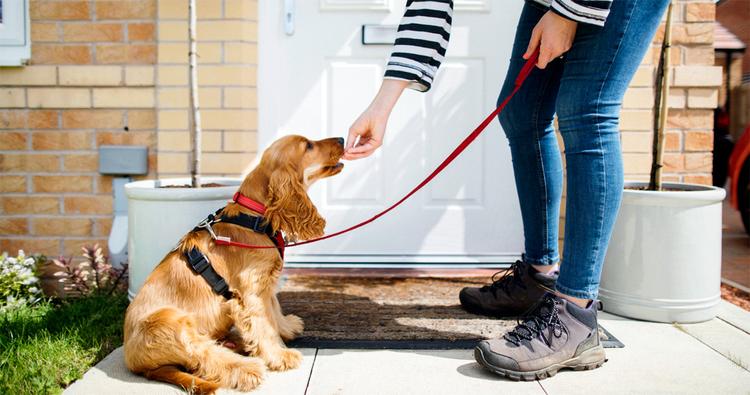How to Crate Train Your Puppy or Dog
Wondering if you should crate train your new pup? Yes, you should! Read on for everything you need to know about introducing your dog to crate-training.
Wondering if you should crate train your new pup? Yes, you should! Read on for everything you need to know about introducing your dog to crate-training.
by Naomi Strollo, RVT, CPDT-KA, | March 18, 2024

sophiecat / Shutterstock
Crate training your new puppy or dog can be a wonderful way for them to have their own space. It can help with potty-training, too. If the introduction (and use of) the crate is done correctly, most puppies and even older dogs will enjoy spending time in their special “den.” That’s right, when crate-training is done right, many dogs will actually choose to hang out in their crate when the door is left open.
Below are some reasons why you’ll want to crate your dog. We’ll also help you choose the right size crate, tips on how to get your dog accustomed to it, and figure out a realistic timeline for results.
Crate training teaches a dog that a crate is a safe, comfortable space to rest in. The idea behind crate training is that you slowly introduce your dog to the crate, ensuring that they feel relaxed there. Crates can help with separation anxiety and other behavioral issues. Most puppies and dogs will try very hard not to soil where they sleep, which is why a properly sized crate can be so helpful when housetraining.
In addition to giving your dog a comfortable place to rest, most trainers recommend crating your dog, because it…
Helps speed-up potty training
Teaches independence
Decreases anxiety
Encourages naps and routines
Keeps them safe
Decreases destruction
Enforces better manners
Prepares them for boarding and hospitalization
A proper crate can be a pivotal purchase for you, among the many items you’ll need for your new dog. There are three types of crates: wire, hard-sided, and soft-sided. Each type comes in different sizes to accommodate toy, miniature, medium, large, and giant dogs. Choose one that is easy to clean and set up, not to mention roomy enough for your dog’s comfort.
It’s best to get your crate in a size that can accommodate your fully grown dog. In other words, the crate should fit the puppy as they grow. The size of the crate should be large enough for them to stand up, turn around, and lay down. Any larger and they will potty in one corner, and push themselves to another corner to get away from it. A crate with a divider is a great idea, because you can make it the size you need, and extend it out as they grow.
Crates can cost anywhere from $30 to $200 (and up). This depends on the crate’s size and durability.
At night, your bedroom is the best location for the crate, because it helps prevent your dog from feeling lonely. During the day, the crate should be in a common area where you spend time, but not a high-traffic area. If moving the crate around doesn’t seem feasible, it’s okay to get a second crate. If you put the crate too far away, then the dog can not seek it out on their own when they want. Consider having two crates in two locations to meet the needs of the dog and family, at least when your pup is new to your household.
Here are a few ways to make the crate a positive space:
Serve meals in the crate with the door open. Leaving the door open allows them to leave if they want. Most dogs will eat the food, because they are deciding to stay on their own. Start by leaving the bowl close to the door, and over time, slowly move it further inside.
Make the crate the center of play. Toss toys into the crate and near the crate. Just like the couch or a chair, it becomes another piece of furniture.
Always toss treats in to encourage them to go in, not always closing the door. This becomes less terrifying if they know the trap door doesn’t automatically close behind them when going in.
By giving them a high-value chewable or lickable treat when inside, you’re providing them with something positive to look forward to.
Never put them in the crate when you’re mad. It’s not a punishment.
Never force them in or pull them out. Use a trail of treats to encourage them to go in, and a trail of treats to coax them out.
You’ll want to keep your dog in the crate any time you cannot watch them. Schedule crate times, so they get used to a routine. Puppies thrive on routine. When they learn they are going into the crate the same time every day, they know when they are coming out. Puppies require 16-18 hours of sleep a day. When they don’t get it, they bite more and listen less. As long as there is movement, they will force themselves to stay awake. Crating them when it’s nap time will encourage this sleep.
Before getting started, there are a few key things to understand about crate training.
Take them out to potty before going into the crate, and after coming out of the crate
Avoid talking or touching them when they’re in the crate, so they don’t learn attention-seeking behaviors
Set the mood to encourage calm behavior
Never leave their collar, harness, or leash on because it could get caught
Don’t allow other dogs or children in their crate
Dogs should not be left in a crate more than thee to four hours at a time (except at night, when they are sleeping)
Start crate training by sitting with your puppy in front of the open crate. Let them sniff a treat, then toss it into the crate, even saying a special cue like “go to crate” or “go to your room.” The second one foot is in, praise and toss your dog another treat.
If they come running out, it’s okay, you can try it again. Do this multiple times until they are running in to get the treats.
Place a few treats under the blanket. When they run in, they will root around to find those hidden treats. Now close the door for a second, and immediately open it.
Repeat this step, gradually increasing the length of time the door stays closed. At times, you can reward them by dropping the treats into the crate. This teaches your pup that treats will come when they are inside.
When your puppy can stay in the crate with the door closed for at least 10 seconds without any signs of anxiety, close the door and take a step away. Return, toss a treat through the top or sides, then open the door.
Repeat this slowly, increasing the time the door is closed and the number of steps you take away from the crate. Vary the times and the distance.
Vary crate times throughout the day. Start with short intervals, like five to 10 minutes, and gradually increase the time. Once they are more comfortable in the crate, build up the amount of time and frequency they spend inside it.
Learning the appropriate way to let your dog out of the crate is just as important as getting them inside. Make sure the puppy is calm prior to letting them out of the crate. When letting them out, always approach the crate and say nothing. Look at them, and wait for them to get quiet.
Once they are quiet for three to five seconds, open the crate and take them outside. This makes it clear that you will only let them out when they’re being quiet or have to go pee. This gives them a clear understanding that making a lot of noise will not “free” them of the crate.
Don’t try to rush to this step too quickly. You do not want to let them cry until they tire themselves into calmness, this should be a positive experience. But if your dog fusses or cries initially, it’s important to not acknowledge this. Take a step back and try shorter intervals the next time.
When you give any attention — negative or positive — to unwanted behavior, you are reinforcing the behavior. The puppy will ultimately learn through this training that when the doors are closed, you will be back. They will understand that this is determined by your schedule, not their whims.
Take a deep breath, because the first night with your puppy will be the hardest. But here’s a silver lining: setting boundaries on day one will make training much easier on you. If you want your dog to sleep with you, they can…after they are potty trained.
If you do this prematurely, a puppy will get off the bed to have accidents, or even worse, relieve themselves in your bed. Puppies cannot hold it through the night, even if they are in a crate. They have little bladders and will need to go out two to three times during the night, depending on their size.
Before putting them in their crate for the night, be sure they have had enough exercise to tire them out. Don’t put food, water, dog beds, or potty pads in the crate. Providing them with a thin blanket or towel to lay on is fine. You can also try giving them stuffed toys with “heartbeats” or something safe to lick or chew on, both of which can help soothe them to sleep. Other tips to relax them include: playing classical music, turning the lights down, providing them with an old shirt with your scent on it, covering most of the crate (with an opening to see out), pheromone collars, and room diffusers.
That timing depends on the individual pooch, because crate training varies by dog. Many puppies can do the whole crate-training program in one day. Some will take several days. A few will take weeks.
We measure success by how well they are progressing. If they decrease their initial whining and crying before they settle down, that’s an improvement. If they can be in the crate with us in the room, that’s a great start. At that stage, we can begin leaving the room for short periods of time. If they are sleeping in the crate at night and only alerting us when they need to go out to pee, this is what we want. After seeing progress, you’ll get even more encouraged to continue on this training path.
Yes, crate training an adult dog is recommended. You can generally follow all the guidelines listed above. However, the biggest difference is that you should only crate train an adult dog if they haven’t had a bad experience with confinement in the past. Unfortunately, you may not know this until you start training.
If your adult dog is triggered by past negative experiences — such as punishment by being put in a crate for many hours (or days) — they will not take to the crate. No matter how positive we try to make it, they’ll panic. Any dog that harms themselves, tries to destroy the crate, or has a panic attack is clearly not a candidate for crate training.
If this is the case, try using an isolation area instead. This is a space or room set up for them, free of anything that could harm them or that they can damage. And instead of closing a door, use a baby gate to block off the area. Treat this area just like you would a crate: Make this a safe space for them. Every dog deserves to feel the security of their own comforting space.
The Benefits of Crate Training
Crate Training - Benefits to Crate Training
Crate Training by Dr. Karen Becker
The Ultimate Guide to Raising a Puppy: How to Train and Care for Your New Dog

Naomi Strollo R.V.T, CPDT-KA, has been a Registered Veterinary Technician for over 20 years. Working in general practice and emergency medicine. Having special interest in behavior, she went on to become Fear Free Certified, and a Certified Professional Dog Trainer - Knowledge Assessed (CPDT-KA). She has participated in therapy dog, confirmation, and CGC certifications with her dogs. With positive-reinforcement training, her Akita, Pitbull, and Shiba Inu know how to be friends. Living in Ohio, she enjoys sharing her knowledge through writing contributions.

Behavior & Training

Adoption Advice

Behavior & Training

Behavior & Training
Make your pup a potty pro with these house training tips.

Adoption Advice
The beginning of puppy parenthood can be rough, but it does get better — especially when you implement this advice.

Behavior & Training

Behavior & Training

Behavior & Training

Behavior & Training

Behavior & Training

Behavior & Training

Behavior & Training